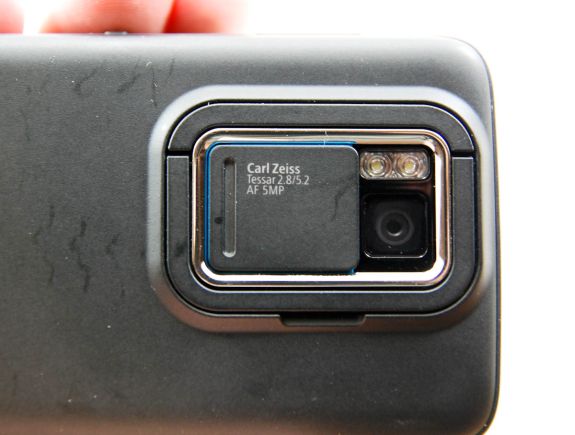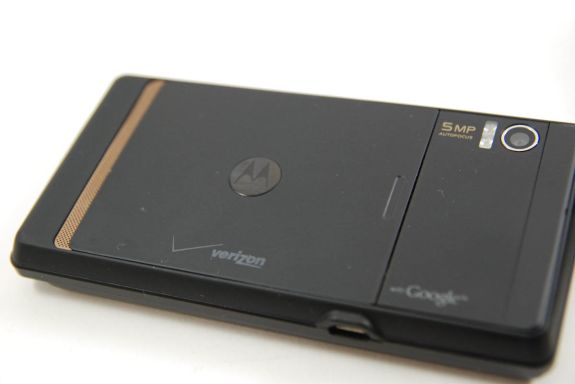Two OMAP 3430 Phones: Nokia N900 and Motorola Droid
by Brian Klug on June 10, 2010 9:29 PM EST- Posted in
- Smartphones
- N900
- Maemo
- Motorola Droid
- Droid
- MeeGo
- Android
- Mobile
N900 Camera
I've already talked briefly about the N900's camera, which is true to form for Nokia devices and pretty impressive. The software implementation that Nokia has put together for the N900 on Maemo is well polished. As mentioned before, sliding the camera cover open while the device is on immediately launches the camera application, or you can get there from the applications window. After launching, there are black bars at each side, the right side of which is used for settings icons. Nokia has included a ton of options here, including optional geotagging, settings for exposure, ISO, and preset shooting modes. You can capture in 3.5 megapixel or 5 megapixel modes, and have ISO 100, 200, 400 or automatic to choose from. In auto mode, it seems like the camera can go all the way to ISO 800 if necessary, but you can't set that manually. True to the rest of Maemo, the camera only works in landscape orientation.
What's really impressive is just how sharp and fluid the N900 camera preview looks while you're shooting. Suffice it to say, only the HTC Incredible really rivals how sharp and detailed the images look in the live preview. Framerate is always solid, and I just left the settings on defaults because I was pleased with the quality. The hardware button itself is two-position. Pushing halfway down triggers autofocus, pressing all the way takes the shot. One of the nice things is that if you jam the shutter button all the way down, it really takes the picture immediately; there's no mandatory AF run before actually capturing. This is potentially really handy if you're trying to capture something quick action and you're already confident it's in focus.
The N900 can capture videos at up to 848x480 at 25 fps in MPEG-4 format with AAC audio. That's an aspect ratio of 16:9 interestingly enough. I was a bit concerned initially about video being shot at 25 fps, but this is becoming more and more the case with 720P class smartphone video. Quality itself is very good as we'll see in a second.
Motorola Droid Camera
The Motorola Droid packs a slightly more standard 5 megapixel camera, also with autofocus and dual LED flash. While it doesn't carry fancy Carl Zeiss branding or advertise what kind of optical lens system drives it, it's likely the same or a very similar OmniVision camera sensor at the core. The Motorola Droid also supports video recording, though at slightly lower 720x480 resolution at slightly higher 30 fps. Video is encoded in H.264 and audio is AAC.
The camera application for the Motorola Droid is also stock Android 2.x. Love it or hate it, the application is essentially uniform across the platform with the exception of HTC's custom camera application like on the HTC Incredible. You've got settings for most of the basic things, but just not as much as you do on the N900 - though both of these have many more settings than iPhone OS which always handles everything with no chance for user override.
The camera can be launched either from the applications menu, or by pressing the dedicated camera button all the way down while the device is on. Motorola talked a fair amount about the copper colored camera button which - I guess - is a feature. Unfortunately, I did encounter a considerable amount of bugginess with the Droid's camera. Launch would periodically take a very long time (well over 8 seconds), in which case you'll probably just give up and move along, and I noticed a very strange quirk where switching from landscape to portrait (eg shutting the keyboard drawer) would result in camera UI elements being drawn in the wrong place. A few times, the frame around the camera preview would just render inside atop the image, which is very frustrating. Killing and relaunching fixes that, though.












68 Comments
View All Comments
tarunactivity - Thursday, June 10, 2010 - link
a notable omission:The FM receiver on the N900 requires Bluetooth to be switched on. So if you want FM, you need to plugin your earphones + enable bluetooth.
Kind of counter productive , if you ask me,and surely a waste of power.
Brian Klug - Friday, June 11, 2010 - link
Ahh, you're totally right. I think I glossed over that because I already had Bluetooth on, but it makes sense now since the FM radio is on that same piece of silicon.I wonder how much of a difference it makes on battery - had it disabled for those other tests of course.
-Brian Klug
asdasd246246 - Thursday, June 10, 2010 - link
I'm sure the Nokia has sweet hardware, but it's still all plastic..Plastic screen that will scratch the first 10 minutes you own it, and a friend has a similar model without a keyboard, and the plasticness is so horrible I shudder.. -_-
legoman666 - Thursday, June 10, 2010 - link
I've had the N900 since last November. No screen protector, no case. Not 1 scratch. So speak for yourself, maybe you ought to put your phone in a separate pocket as your keys.legoman666 - Thursday, June 10, 2010 - link
back: http://imgur.com/tf6RE.jpgfront: http://imgur.com/XDsyI.jpg
akse - Friday, June 11, 2010 - link
The case is somewhat plastic yeah.. but it hasn't really bothered me so much. I have only a few tiny tiny scratches on the screen, you can only spot them by mirroring a clean screen against bright light.At the back I have a few bigger scratches because the phone fell on concrete..
Calin - Friday, June 11, 2010 - link
I have a 1200-series Nokia phone, which I keep in the same pocket as the keys, and the display is in a serviceable condition after more than two years of abusearnavvdesai - Thursday, June 10, 2010 - link
Actually, the Symbian OS- Nokia's No.1 Smartphone OS is more open with entire OS(including the core APIs) being Open Source. Symbian is more open than Android.Talcite - Friday, June 11, 2010 - link
That's only true for symbian^3 and newer OSes. Only the Nokia N8 is currently shipping S^3 I believe.You should also mention that the Maemo 5 OS has many binary packages to get all the cellular hardware and PowerVR GPU working.
Anyways, it definitely has more support for the FOSS community than android though as far as I know. You're free to flash your own ROMs without needing to root it and you don't need to do weird stuff with java VMs. Just a simple recompile for ARM and support for Qt I think.
teohhanhui - Friday, June 11, 2010 - link
Nokia N8 is still far from "currently shipping"...